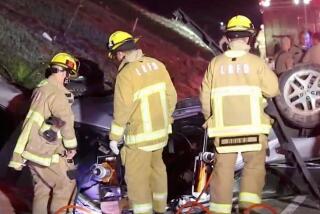EARTHQUAKE / LIFELINES OF L.A. : Life in the Fast Lanes: A Look at Milestones in Freeway History
- Share via
After billions of dollars in construction costs spent over decades, Los Angeles now struggles to rebuild quake-mangled freeways. Here are some milestones in the life and lore of Los Angeles County’s 528-mile freeway system.
* 1940: The state’s first freeway is built in the San Gabriel Valley. The opening of the Arroyo Seco Parkway, later called the Pasadena Freeway (Interstate 110), ushers in an era of great highway construction for the West Coast.
* 1943: State lawmakers pass a bill renaming the portion of U.S. Highway 6 from San Pedro to the Nevada border as the Grand Army of the Republic Highway, which was an organization formed in 1866 to assist wounded and sick Civil War veterans.
* 1947: Construction of the Los Angeles freeway system begins in earnest, including the key Downtown interchange uniting individual freeways into one system. State legislators pass a bill 73 to 1 banning smog.
* 1949: At Aliso Street in Downtown Los Angeles, the state Transportation Department begins constructing the western end of a new six-lane Ramona Freeway. Six years later, state officials would change its name to the San Bernardino Freeway. They thought naming the freeway after its destination made more sense than naming it for a fictional character in a novel and play by Helen Hunt Jackson.
* 1955: Socialite Evelyn Throsby Scott disappears from her North Bentley Avenue estate, a few blocks from the Sunset Boulevard off-ramp of the northbound San Diego Freeway, which was under construction. Some people believe her body is entombed here. Although her body was never found, her husband, L. Ewing Scott, a paint salesman, was convicted of murder.
* 1956: President Dwight D. Eisenhower signs the Interstate Highway Bill, providing 41,000 superhighway miles to crisscross the nation.
* 1966: Final section of the Santa Monica Freeway, linking Downtown Los Angeles with the coast, opens after 12 years of construction, costing about $210 million.
* 1971: A magnitude 6.4 earthquake sends parts of the Golden State and Antelope Valley freeways crashing to the ground, causing $15 million in damage to the freeways and interchanges in the Sylmar area.
* California 90, which runs from the San Diego Freeway to Marina del Rey, is named the Richard M. Nixon Freeway. Five years later--after Watergate--it is renamed the Marina Freeway.
* 1972: Ventura Freeway is immortalized in a song called “Ventura Highway” written by Lee Bunnell and performed by the group America.
* A section of bridge on the Foothill Freeway over the Arroyo Seco in Pasadena collapses, killing six workers and injuring six others. Improper bracing of scaffolding is blamed for the accident.
* 1973: The nation’s first station built for commuters using the busway lane from El Monte to Los Angeles opens in El Monte on the San Bernardino Freeway.
* Songwriter Guy Clark, fed up with Los Angeles, moves to Nashville, taking with him the idea for “L.A. Freeway,” a glad-to-be-leaving song that became a modest pop hit for Jerry Jeff Walker.
* 1974: Terminal Island Freeway opens. When scheduling permits it is used for the shooting of chase scenes for such movies as “To Live and Die in L.A.,” “Terminator II” and “Air America.”
* 1976: A lane on the Santa Monica Freeway is removed from general traffic, painted with white diamonds and used exclusively for vehicles carrying at least three people. But after five months of turmoil, confusion and adverse reactions, the diamond lane is pronounced dead by a court order.
* During the oil crisis, one of the first electronic puns appears along the Santa Monica Freeway: lighted message signs warning motorists “Don’t Be Fuelish, Be Car-Poolish.” Then there was “Take the Train,” which provoked this universal response: “What train?”
* 1978: A stretch of the Glendale Freeway between the Ventura and Foothill freeways is renamed for Frank Lanterman, a state assemblyman who died in 1981.
* 1980: Songwriters Sandy Pinkard and Larry Collins give fame to the Santa Monica Freeway with their country-Western song “You’re the Reason God Made Oklahoma,” because it contains the lyric “Santa Monica Freeway sometimes makes a country girl blue-ooh-ooh-ooh.” The next year, singer David Frizzel makes it a No. 1 on the country charts.
* 1981: The final stretch of the 48.5-mile Foothill Freeway opens, connecting the Golden State Freeway near Sylmar with the San Bernardino Freeway. The cost of the 14-year project amounted to $231 million. Many episodes of the “CHiPS” TV series, featuring Eric Estrada and Larry Wilcox as officers Ponch and Jon, were filmed between Pacoima and the Glendale Freeway from 1977-1981.
* 1990: A crane loading a 12,000-pound concrete freeway barrier onto a flatbed truck topples, crushing the truck driver on the Century Freeway project in Inglewood.
* 1993: Motorists begin using the Glenn M. Anderson Freeway, (also known as the Century Freeway) named for the retired congressman who pushed for its construction. Transportation officials say they believe that the $2-billion freeway, 17.3 miles between Norwalk and El Segundo, will probably be Southern California’s last new freeway because of costs and environmental problems.
* 1994: Portions of four Los Angeles County freeways are crippled in a magnitude 6.8 earthquake. Among the hardest hit are two of the region’s busiest routes: the Santa Monica Freeway near La Cienega Boulevard and Fairfax Avenue, where an elevated portion of roadway toppled onto the street below, and the junction of the Antelope Valley (California 14) and Golden State Freeway (I-5) overpass.
More to Read
Sign up for Essential California
The most important California stories and recommendations in your inbox every morning.
You may occasionally receive promotional content from the Los Angeles Times.









